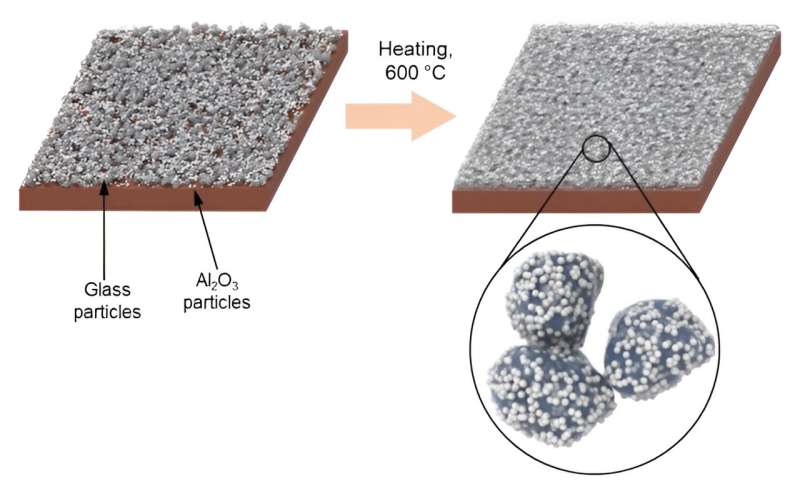This article has been reviewed according to Science X's editorial process and policies. Editors have highlighted the following attributes while ensuring the content's credibility:
fact-checked
peer-reviewed publication
trusted source
proofread
Researchers' 'cooling glass' blasts building heat into space

University of Maryland researchers aiming to combat rising global temperatures have developed a new "cooling glass" that can turn down the heat indoors without electricity by drawing on the cold depths of space.
The new technology, a microporous glass coating described in a paper published Nov. 9 in the journal Science, can lower the temperature of the material beneath it by 3.5°C at noon, and has the potential to reduce a mid-rise apartment building's yearly carbon emissions by 10%, according to the research team led by Distinguished University Professor Liangbing Hu in the Department of Materials Science and Engineering.
The coating works in two ways: First, it reflects up to 99% of solar radiation to stop buildings from absorbing heat. More intriguingly, it emits heat in the form of longwave infrared radiation into the icy universe, where the temperature is generally around -270°C, or just a few degrees above absolute zero.
In a phenomenon known as "radiative cooling," space effectively acts as a heat sink for the buildings; they take advantage of the new cooling glass design along with the so-called atmospheric transparency window—a part of the electromagnetic spectrum that passes through the atmosphere without boosting its temperature—to dump large amounts of heat into the infinite cold sky beyond. (The same phenomenon allows the earth to cool itself, particularly on clear nights, although with much less intense emissions than those from the new glass developed at UMD.)
"It's a game-changing technology that simplifies how we keep buildings cool and energy-efficient," said Assistant Research Scientist Xinpeng Zhao, the first author of the study. "This could change the way we live and help us take better care of our home and our planet."

Unlike previous attempts at cooling coatings, the new UMD-developed glass is environmentally stable—able to withstand exposure to water, ultraviolet radiation, dirt and even flames, enduring temperatures of up to 1,000°C. The glass can be applied to a variety of surfaces like tile, brick and metal, making the technology highly scalable and adoptable for wide use.
The team used finely ground glass particles as a binder, allowing them to avoid polymers and enhance its long-term durability outdoors, Zhao said. And they chose the particle size to maximize emission of infrared heat while simultaneously reflecting sunlight.
The development of the cooling glass aligns with global efforts to cut energy consumption and fight climate change, said Hu, pointing to recent reports that this year's Fourth of July fell on what may have been the hottest day globally in 125,000 years.
"This 'cooling glass' is more than a new material—it's a key part of the solution to climate change," he said. "By cutting down on air conditioning use, we're taking big steps toward using less energy and reducing our carbon footprint. It shows how new technology can help us build a cooler, greener world."
Along with Hu and Zhao, mechanical engineering Professor Jelena Srebric and Professor Zongfu Yu from the Department of Electrical and Computer Engineering at the University of Wisconsin-Madison are co-authors of this study, contributing their expertise on building CO2 savings and structure design, respectively.
The team is now focusing on further testing and practical applications of their cooling glass. They are optimistic about its commercialization prospects and have created the startup company CeraCool to scale up and commercialize it.
More information: Xinpeng Zhao et al, A solution-processed radiative cooling glass, Science (2023). DOI: 10.1126/science.adi2224

















